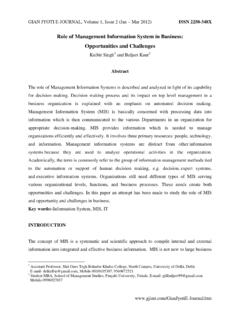Transcription of Emerging Trends in Information and Communication …
1 GIAN JYOTI E-JOURNAL, Volume 6, Issue 3 (July-Sept 2016) ISSN 2250-348X 13th National Conference on Management, Information Technology and Engineering (GJ-NatConMITE 2016) Saturday, 23rd July, 2016 at GJIMT, Sector-54, Mohali-160055, Punjab, India 1 Emerging Trends in Information and Communication Technology Mukesh Kumar1 Abstract Today is the age of Information Technology. It has changed the lifestyle of the people. There is hardly any field of human life that is not affected by the Information Technology.
2 Various Technological Trends like Cloud Computing, Mobile Computing, Social media, Ubiquitous computing are growing very fast. Cloud computing enable us to share hardware and software resources as a service over the internet on the pay per use basis with any user over the globe. Mobile computing help us to access and process data on handheld mobile devices like smart phones, iPads etc. Social media like Facebook, twitter, Whatsapp, YouTube, LinkedIn help peoples to interact with each other around the world.
3 Social media is also contributing to make this world a better place to live by raising issues of social importance. Internet of Things (IoT), a network of large amount of objects, computing devices embedded with microchips, sensors, actuators making this world a smart place to live. In this paper we will discuss about the various Trends of Information and Communication technology like Cloud computing, Mobile computing, Social media and Internet of Things (IoT) that is evolving very rapidly and also discuss their role in professional and social life.
4 Keywords Information Technology, Cloud Computing, Mobile Computing, Social Media, Internet of Things (IoT) I. INTRODUCTION Information Technology has affected the human being almost in all sphere of life whether it is education, healthcare, business, Communication or our day to day tasks. Information Technology helps us to gather, handle and interconnect large volume of data and Information . Various technologies in IT is growing very fast like cloud computing, mobile computing, social media etc which is changing the way of doing the jobs.
5 With the help of cloud computing we are able to get hardware and software resources virtually on pay per demand basis. This helps an individual as well as organizations to avoid installing heavy and costly software on their systems. Through cloud computing we are able to get applications, platforms as well as infrastructure over the internet. Mobile computing enables human beings to access and process data on their mobile devices as with the speed of personal computer. Social media helps to interact with the peoples over the globe in a very user friendly manner.
6 Wireless devices are becoming very popular these days. Ubiquitous computing or Internet of Things (IoT) is making almost every object IT enabled that can sense, process as well as transmit data among different objects in real time over the existing networks. This helps us to control the objects remotely and thus saving our time. Ubiquitous computing is the major area of research these days and in the coming years number of objects that are embedded with computing device will increase very fast. II.
7 CLOUD COMPUTING Cloud Computing is a recent advancement in Information technology that is Emerging very rapidly. It is a pool of shared resources which includes server, storage, networks, services and applications that can be shared with individuals as well as with organization on pay per use basis in a cost efficient manner. Cloud computing services are usually owned and managed by the third party providers who deliver the services to the user on pay per-use basis. GIAN JYOTI E-JOURNAL, Volume 6, Issue 3 (July-Sept 2016) ISSN 2250-348X 13th National Conference on Management, Information Technology and Engineering (GJ-NatConMITE 2016) Saturday, 23rd July, 2016 at GJIMT, Sector-54, Mohali-160055, Punjab, India 2 Fig 1: Cloud Computing [2] A.
8 Cloud Computing Services Software as a Service (SaaS): SaaS is the very familiar type of cloud service to the customers. Software as a Service is the topmost layer of cloud computing architecture which offers complete application to the customer over the internet. Among the most familiar software as a Service (SaaS) applications for businesses are CRM application like Salesforce, storage solutions like Google Drive, Drop box and productivity applications suit like Google apps. Platform as a Service (PaaS): Platform as a Service is the middle layer of cloud computing architecture which offers execution environment as a service for the software without any need of downloading software or installation of software for the developers or end users.
9 Examples of PaaS are Microsoft Azure and Google App Engine. Infrastructure as a Service (IaaS): Infrastructure as a Service is the bottom layer of cloud computing architecture which offers sharing of the hardware resources through virtualization for executing services. The main motive is to make resources such as storage, network and servers readily available and accessible by the operating systems. It provides on demand and pay on per use basis services. Examples of IaaS are Amazon EC2, S3. B. Types of Cloud Computing Public Cloud: In this type of Cloud Computing no restrictions on access of services are applied and no authentication or authorization techniques are implemented in this model.
10 These clouds provide the facility of long term data storage. Examples of public cloud are Google App Engine and Microsoft Azure. ` Private Cloud: This type of Cloud Computing is implemented within the firewall of the organization. This cloud is designed to provide same services and features as that of public cloud but remove problems related to security issues. Private cloud provides more control over the organization s data which ensures security. GIAN JYOTI E-JOURNAL, Volume 6, Issue 3 (July-Sept 2016) ISSN 2250-348X 13th National Conference on Management, Information Technology and Engineering (GJ-NatConMITE 2016) Saturday, 23rd July, 2016 at GJIMT, Sector-54, Mohali-160055, Punjab, India 3 Community Cloud: This type of Cloud Computing provides the facility of sharing computing infrastructure among the organizations of same communities.


